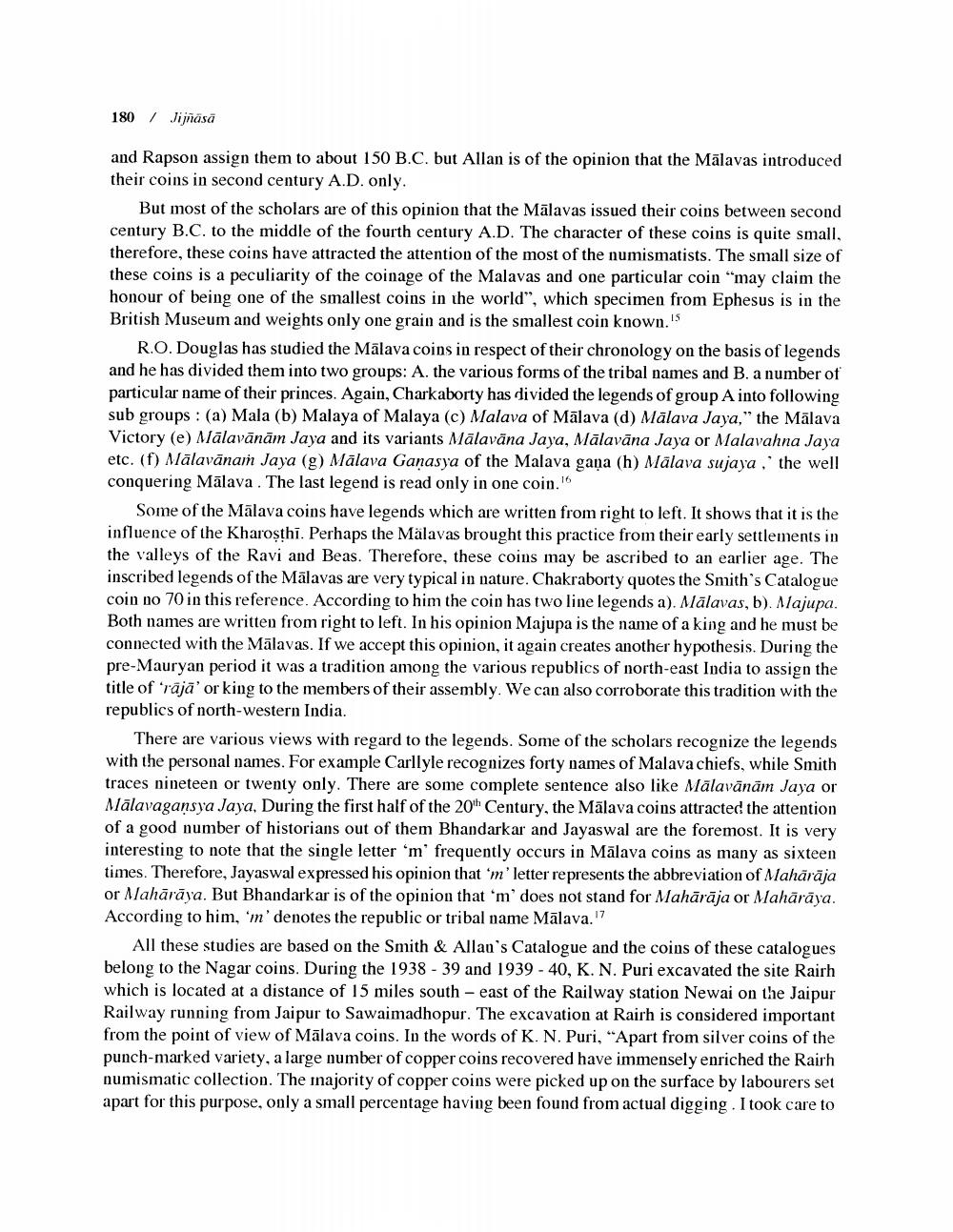________________
180 / Jijñāsā
and Rapson assign them to about 150 B.C. but Allan is of the opinion that the Mālavas introduced their coins in second century A.D. only.
But most of the scholars are of this opinion that the Malavas issued their coins between second century B.C. to the middle of the fourth century A.D. The character of these coins is quite small, therefore, these coins have attracted the attention of the most of the numismatists. The small size of these coins is a peculiarity of the coinage of the Malavas and one particular coin "may claim the honour of being one of the smallest coins in the world", which specimen from Ephesus is in the British Museum and weights only one grain and is the smallest coin known. IS
R.O. Douglas has studied the Malava coins in respect of their chronology on the basis of legends and he has divided them into two groups: A. the various forms of the tribal names and B. a number of particular name of their princes. Again, Charkaborty has divided the legends of group A into following sub groups: (a) Mala (b) Malaya of Malaya (c) Malava of Malava (d) Malava Jaya," the Malava Victory (e) Mālavānām Jaya and its variants Mālavāna Jaya, Malavana Jaya or Malavahna Jaya etc. (f) Mālavānam Jaya (g) Malava Gaṇasya of the Malava gaṇa (h) Mälava sujaya, the well conquering Malava. The last legend is read only in one coin. 16
Some of the Malava coins have legends which are written from right to left. It shows that it is the influence of the Kharoṣthi. Perhaps the Mälavas brought this practice from their early settlements in the valleys of the Ravi and Beas. Therefore, these coins may be ascribed to an earlier age. The inscribed legends of the Malavas are very typical in nature. Chakraborty quotes the Smith's Catalogue coin no 70 in this reference. According to him the coin has two line legends a). Mālavas, b). Majupa. Both names are written from right to left. In his opinion Majupa is the name of a king and he must be connected with the Malavas. If we accept this opinion, it again creates another hypothesis. During the pre-Mauryan period it was a tradition among the various republics of north-east India to assign the title of 'raja' or king to the members of their assembly. We can also corroborate this tradition with the republics of north-western India.
There are various views with regard to the legends. Some of the scholars recognize the legends with the personal names. For example Carllyle recognizes forty names of Malava chiefs, while Smith traces nineteen or twenty only. There are some complete sentence also like Mālavānām Jaya or Malavagansya Jaya, During the first half of the 20th Century, the Malava coins attracted the attention of a good number of historians out of them Bhandarkar and Jayaswal are the foremost. It is very interesting to note that the single letter 'm' frequently occurs in Malava coins as many as sixteen times. Therefore, Jayaswal expressed his opinion that 'm' letter represents the abbreviation of Mahārāja or Mahārāya. But Bhandarkar is of the opinion that 'm' does not stand for Mahārāja or Mahārāya. According to him, 'm' denotes the republic or tribal name Mālava."7
All these studies are based on the Smith & Allan's Catalogue and the coins of these catalogues belong to the Nagar coins. During the 1938 - 39 and 1939 - 40, K. N. Puri excavated the site Rairh which is located at a distance of 15 miles south-east of the Railway station Newai on the Jaipur Railway running from Jaipur to Sawaimadhopur. The excavation at Rairh is considered important from the point of view of Malava coins. In the words of K. N. Puri, "Apart from silver coins of the punch-marked variety, a large number of copper coins recovered have immensely enriched the Rairh numismatic collection. The majority of copper coins were picked up on the surface by labourers set apart for this purpose, only a small percentage having been found from actual digging. I took care to




